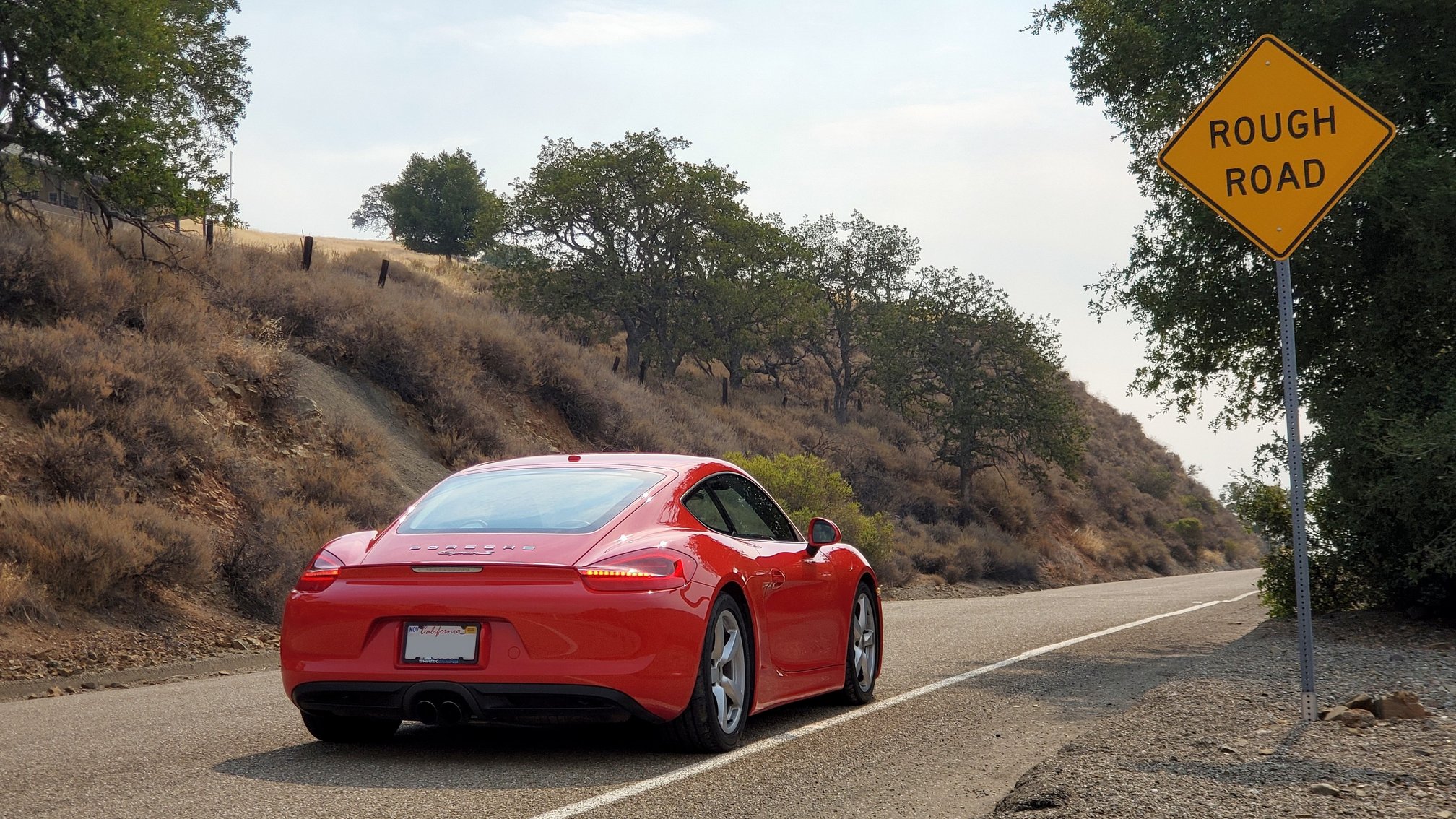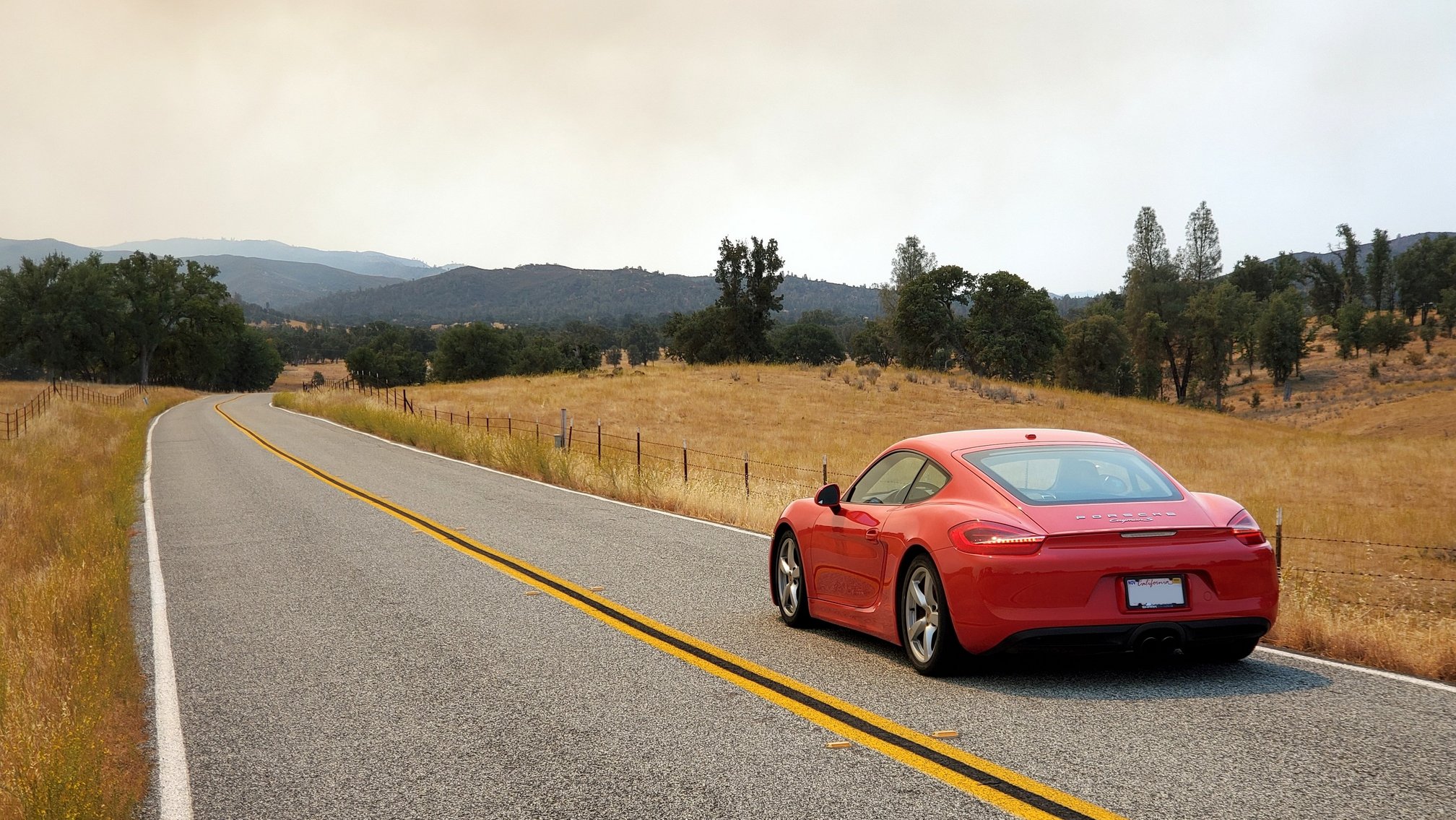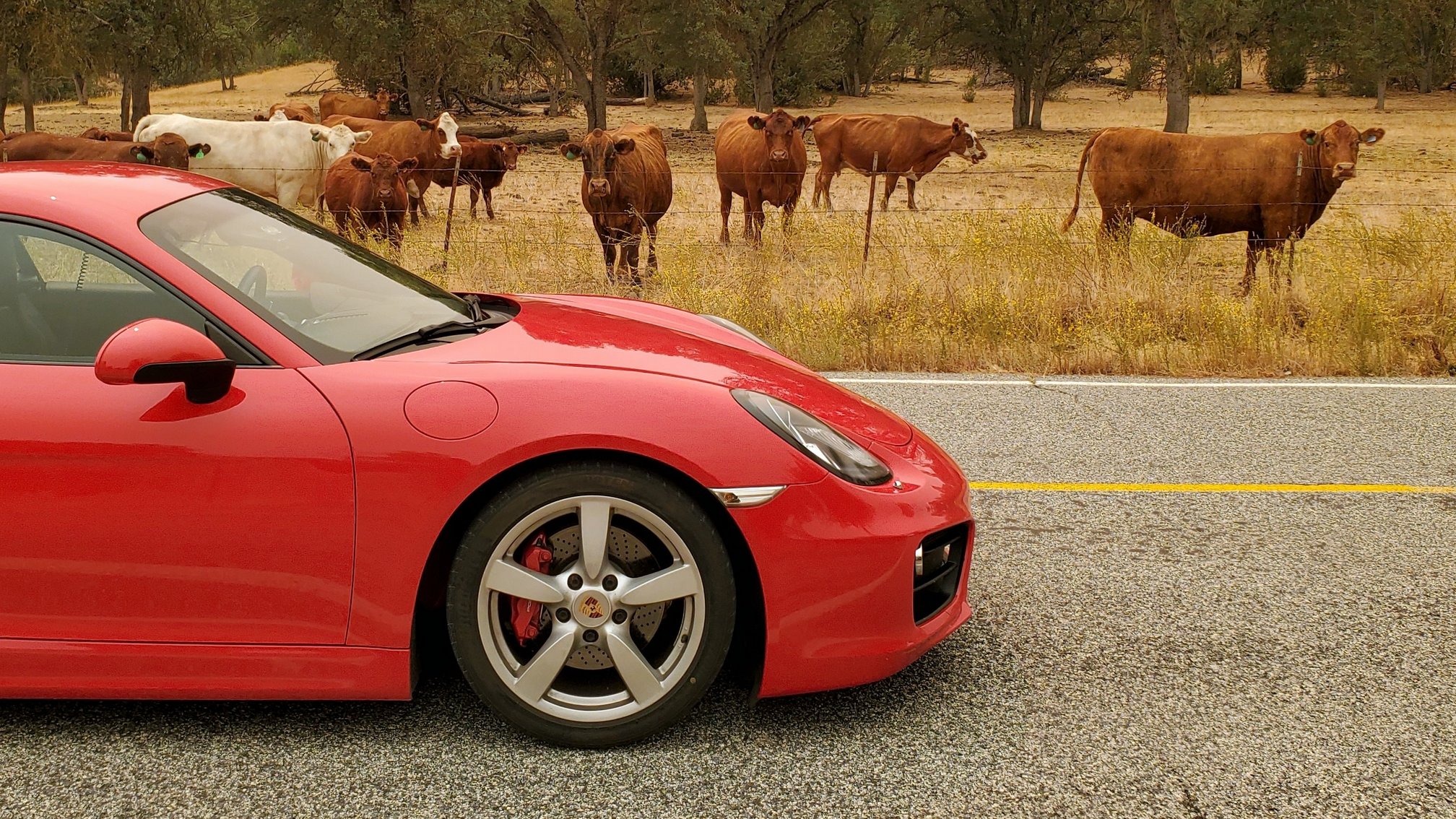Seeing is believing. Or, when it comes to cars, driving is believing. I bring this up because the 2014 Porsche Cayman S is precisely as the journalists describe it: the most amazingly balanced, infallibly-agile Porsche that sings God’s own music but needs another 75 hp or a close-ratio gearbox. Yet, I had to drive it to understand it. I’m afraid, dear reader, the same will be true for you, but I’ll try my best to convey the joy—and pain—of the Porsche Cayman S. (If I fail, please go drive one of these magnificent cars and discover their essence yourself!)
As is usual with Porsche, the devil is in the details, and the model name alone doesn’t tell you how any particular Cayman will drive. This Cayman is an S, which means it gets a naturally-aspirated 3.4L six-cylinder engine. This Cayman comes with PDK and Sports Chrono, so it clicks-off the fastest shifts in the business. And, most importantly, this Cayman is equipped with Porsche’s sports suspension.
Rennslist rats swear by this suspension (which is sometimes referred to as the x73 suspension, per its order code) and say it completely transforms the Cayman’s handling. The sports suspension lowers the car by 20 mm and includes (non-adjustable) shocks and stiffer sway bars and springs. I’ve tested base-suspension Caymans and really loved their feel, so my focus today is the transformational sports suspension. Is its praiseworthy handling worth its stiff ride and ground-clearance compromises?

Just getting my show on the road is a test of the compromises. My obstacle? The modest drainage between the driveway and street. To avoid scraping pretty red paint off the Cayman’s chin, its owner lays a rubber mat down to span the drainage gutter. He then acts as a spotter, directing my approach and telling me to cut hard-left before the transition. I hold my breath as I creep forward onto the mat, then into the street. From outside, I see a bright thumbs up: I’ve cleared! I’m on my way!
If your city has open storm drains or steep driveways, you’ll want to skip the lowered sports suspension!

Driving out of town, the sports suspension causes me more consternation. I’m bounced around unpredictably, like a small child sitting on the edge of a trampoline. Bumps that would be nothing in other sports cars jostle in the Cayman. What little ride comfort I have comes from the softly padded driver’s seat.
Soon I’m at Mines Road. The fluids are warm, and I start to explore the Cayman’s dynamics. The road writhes and heaves, but the suspension shrugs off the bumps, perfectly keeping the tires gripping the road. Too bad the machine still needs a human in the driver’s seat: I feel like a whiny bobblehead behind the wheel.

Most cars require a pause between the driver’s initial steering input and the suspension handling the transferred weight and settling into a cornering set. Not so in a sports suspension Cayman! As soon as I’ve fed in enough angle to get the car rotating, the outside tires are loaded, and the Cayman is ready to pounce. This magic may come from the almost-zero body roll of the Cayman. Side-to-side transitions are immediate and flawless. The sports suspension Cayman corners like a race car!
When the road straightens, I turn my attention to the Cayman’s engine. The S’s 3.4L flat-six makes 325 hp and 273 lb-ft. 325 hp isn’t much these days, but the Cayman S weighs a scant 2,910 lbs, so it keeps up with more powerful cars. The meat of the power arrives at 5.5k rpm, and the forceful thrust is sustained to the 7.5k rpm redline.

Work it hard, and the 3.4L makes the best sounds ever! The tone and timbre change as it’s wound out, going from growl to howl, then yowl. The induction noises are bold and loud, and as sweet as those from a GT3 Metzger six. To my surprise, the engine sounds the same in the cabin with the sports exhaust turned on or off. The only difference is that when the loud exhaust light is lit, there’s a rumble of distant artillery fire whenever I release the throttle. Porsche has added overrun burbles for fun!
The road unfurls in the San Antonio Valley, and I wood the throttle. A firm upshift at 72 mph takes me from second gear into third, and I run to the redline again. As I nick the limiter, the speedometer reads 101 mph. 101 mph in third gear! (I never learn the top speed of fourth.) Yes, the gearing is very long. It slows the building revs and relegates fourth through seventh gears to cruising.

I’m roaring over rippled pavement that has a history of pulling sports cars towards ditches. (See my Shelby GT350 review.) But the Cayman tracks straight and true, free of nasty tram-lining habits. The high-speed inertia smooths out the sports suspension’s ride but makes the Cayman clobber its bump stops on severe ruts. (I also scrape the underbody on the ruptured pavement.) I significantly slow for the cattle guards that cross the road; I’d like to avoid damaging the Cayman’s chin.
The road loops as it finds the path of least resistance up Mt Hamilton’s steep flank. The tight hairpins stack up, coming one after another. Here the Cayman’s tall gearing and modest torque are a problem. The suspension’s stellar grip lets the Cayman blitz the hairpins at 30 mph, but 30 mph is 3.5k rpm in second gear, which is well below the engine’s powerband. I’m forced to make short visits to first gear to get the scoot that slings me out of the corners (or wags the car’s tail). But the inevitable upshift to second gear drops the revs to 4.5k rpm and out of the powerband. (The difference in power between 7.5k rpm in first and 4.5k rpm in second is so big that it feels like traction control has pulled the throttle.) Back in second again, I wish for more torque.

The hairpins also reveal the Cayman’s grip-over-slip priorities. In other cars—front-engined rear-drive cars with more torque—I’d enter the hairpins on the racing line and goose the throttle post-apex to pivot out of the corner. The Cayman doesn’t have the grunt to booty shake on gas alone. To wag this dog, I have to turn in with excessive aggression, make the Cayman whip its tail around, and then peg the throttle. I’m (inconsistently) rewarded with minor over-rotation, which is trimmed by the ESP. (The ESP is never completely off.)
At the top of Mt Hamilton, I sit in the shade of an oak tree, munch on my PB&J, and consider my climb. The Cayman sings, dances, and (its tachometer) reaches for the sky. It corners more eagerly than any car I’ve ever owned. But where’s my perma-grin? Why am I sitting here with the emotional excitement of a chewing-cud cow?

I’m driving this Cayman because I’m shopping for a new car. I want to replace my E90 M3 with a track-ready coupe with a high-revving engine. Essentially, a Cayman S! Yet I’m bemoaning the Cayman’s low stance, jolting ride, and feeble low-rpm punch. Am I wrong? Maybe I really want another large-displacement hoon machine?
Unfortunately, I attend track days at most four times a year, so a track-only car would sit. For my next car to get driven, it must do daily school runs as well as spur-of-the-moment canyon drives. A month ago, I took the fact that Porsche sells child seats for the Cayman to mean that it’s school-run safe. But further investigation uncovered a Europe-only Porsche ISOFIX kit (with in-seat ISOFIX hooks and an airbag-deactivation module) that is incompatible with US Caymans. So, is it really safe to put a child in a North American Cayman without the ISOFIX kit? And for my impromptu canyon runs, I wish for a hoon machine. Ugh, I’ve got decisions to make!
I pack up my lunch, peek to see if the Cayman has an ISOFIX hook hidden on the parcel-shelf behind the passenger seat (it does!), and fire up the engine. It’s time to scoot down the mountain to San Jose.

Reenergized, I direct my laser focus on the car’s steering feel. Sadly, this 981-generation Cayman hails from the dark valley of Porsche’s first-generation EPAS. Older 987-generation Caymans came with hydraulic steering; their wheels pulsed with the full spectrum of road textures, drivetrain vibrations, tire impacts, and suspension undulations that thrilled my fingertips. Newer 718 Caymans—from 2017 on—got Porsche’s second-generation EPAS, which delighted with steering weight that ebbed and flowed with tire load and a rack that still transmitted a teaspoon of road grain. But the 981 Cayman’s EPAS erases all tire load information and blocks out all but the coarsest pavement textures. Yes, I can feel the sharp impacts from pavement cracks and the tugging from changing road camber, but the 981 is a low point in Porsche steering feedback. (More than once, I learn about an unloaded front tire from ABS intervention rather than steering feedback.)
The steering weight is another head-scratcher. It is heavy, and—when combined with a wider steering wheel and slower steering ratio—it hides Cayman’s agility. The portly Alfa Romeo Giulia Quadrifoglio uses light and lightning-fast steering to flit into corners like a feather blown by the wind. The actually featherlight Cayman moves with the deliberate action of a steel hammer driving towards a nail. Yet, if I let my hands fly, the Cayman always keeps up. It’s undoubtedly one of the most agile cars I’ve driven.

I chase an odd road fellow, a right-hand-drive Jeep Wrangler, into suburban San Jose. The Wrangler was breaking a sweat on Quimby Road’s tight turns, but it would never wince at the challenge I’m now facing, a gas station driveway ramp. As a Porsche sports suspension driver must do, I eye the ramp with suspicion, hold my breath, and then approach at a sharp angle… I’ve cleared! Dear everyone, buy a Cayman with a different suspension for daily duty.
As premium fuel splashes into the tank, I mull over the 2014 Cayman’s place in history. With its fixed suspension, naturally-aspirated engine, dual-clutch transmission, EPAS steering, and always-active stability control, the 981 Cayman straddles the gap between the analog sports cars of the past and the digitally-efficient performance cars of the future. What I’ve relished today—the engine, chassis, and suspension—are old-school technologies polished to perfection. I’m not ready for whatever turbo-hybrid self-driving 9XX Cayman the future may bring. To push my ideal 981 Cayman into the past, I’d row my own with a 6-speed manual transmission.

The tank is brimmed, and it’s time to retrace my route and return the Cayman. After re-summiting the mountain and diving down into the San Antonio Valley, it dawns on me that I need to up my game to meet the Cayman’s. The Cayman’s front tires are always perfectly pinned; there must be more turn-in than I’ve exploited. Its back tires are difficult for me to unstick; I must be leaving the cornering grip untapped. My slow hands and deliberate inputs are accommodations for lesser cars. I’ve been feeding baby food to the Cayman, but it’s hungry for five-course dinners. I need a track to find the Cayman’s limits and improve mine. No wonder the GT3 boys promote the 981 Cayman as a budget alternative…
My thoughts are as twisted as a pretzel after five hours in the Cayman. Driving is believing, and I now feel in my hands, inner ears, and bum what the magazines promised. The Cayman S is light and lithe, an incredible steer, and a track delight. Its engine sings a scintillating song. Rev it out, and it leaves me—and my neighbors—shouting expletives into the ether. It’s attainably priced and purportedly robust. The Cayman S is practically an MX5 Miata with a Stuttgart badge. What more could I want? How about torque, steering feel, suspension compliance, ground clearance, and child safety? Hmm, it seems I want a daily driver. (If the Cayman fits your needs, don’t let my personal confusion hold you back!)

While I’ve got some priorities to set straight, I’ll write down my perfect Cayman in case the Porsche eventually comes out on top. I’d take an S or GTS with a 6-speed manual, adjustable PASM suspension, factory torque-vectoring LSD, Sports Chrono package, and sports seats with adjustable lumbar support. That should give me the most engaging, most comfortable Cayman S and a chance at kicking the tail out the next time I’m in the hairpins.

8/22/20 1:25AM
